(630) 682-4700
2655 Warrenville Road, Suite 225, Downers Grove, IL 60515
Better information about your collection, water, and stormwater systems
Explore ClarityBetter information about your collection, water, and stormwater systems
Explore Clarity
RJN Group, Inc., is an award-winning engineering firm specializing in the asse...
In 2014, RJN found the City of Joliet had numerous interceptors in poor condition. One of which, the large-diameter Rock Run Interceptor (RRI), was flagged as a high priority due to its proximity to the Rock Run Creek.
The City once again engaged RJN to develop rehabilitation designs for the RRI and, based on its size and location, cured-in-place-pipe (CIPP) was identified as the optimal rehabilitation method. Also, approximately 111 in-line manholes were to be concurrently rehabilitated as part of the project.
With the problem and solution in focus, the task of putting boots on the ground began. Plans were developed to bypass flows using massive pumps and thousands of feet of bypass pipe that crossed waterways and public trails. Additionally, ingress/egress arrangements had to be made with the Forest Preserve District of Will County, which required cutting trees and developing appropriate construction protections for the adjacent areas.
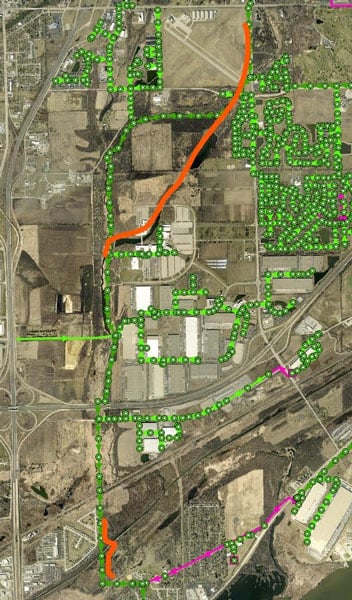 The RRI is a large-diameter reinforced concrete sanitary interceptor tributary to the City of Joliet’s Westside WWTP, carrying average daily flows (ADF) of 10 MGD and peak daily flows of 15 MGD without accounting for inflow and infiltration (I/I). Its diameter ranges from 42 inches to 60 inches as it approaches the WWTP. Much of the RRI is located in a remote forest preserve along Rock Run Creek.
The RRI is a large-diameter reinforced concrete sanitary interceptor tributary to the City of Joliet’s Westside WWTP, carrying average daily flows (ADF) of 10 MGD and peak daily flows of 15 MGD without accounting for inflow and infiltration (I/I). Its diameter ranges from 42 inches to 60 inches as it approaches the WWTP. Much of the RRI is located in a remote forest preserve along Rock Run Creek.
In 2015, the interceptor was inspected with laser, sonar, and HDCCTV multi-sensor technology which found signs of significant deterioration due to the effects of hydrogen sulfide attack. Almost all inspected segments had visible aggregate, the beginning stages of corrosion, or exposed reinforcement. To avoid cherry-picking segments, the City determined to address the areas with the most badly deteriorated pipes and rehabilitate two sections along the creek comprising about 6,500 linear feet of 42-inch pipe and 2,650 linear feet of 48-inch pipe
The route started north of a fire station, which required 24/7 ingress/egress to be maintained. It then crossed the approach path for the Joliet Regional Airport and continued along the creek, crossing rural roads on its way and picking up pumped flows from neighboring districts. At the southern end, the sewer crossed under the Illinois and Michigan Canal (I&M), which is under the United States Army Corps of Engineers (USACE) control.
Engaging and managing the needs of all of the relevant parties was a major undertaking. The primary agencies involved were:
The bypass pumping for such large interceptors required an extraordinary amount of planning, as its path encompassed a canal, creek, airport, and trail. The bypass system comprised three 12-inch pumps and an 18-inch suction discharge, capable of pumping over 30 MGD.
The bypass had saddles fused to take tributary flows which were picked up with smaller pumps and hoses. In addition to the main bypass, a smaller 1,000-foot pipe conveyed flows that discharged from a neighboring municipality via force main into the RRI.
The bypass contractor also installed a pigging port to keep the bypass clean of deposits when it was being used over eight weeks.
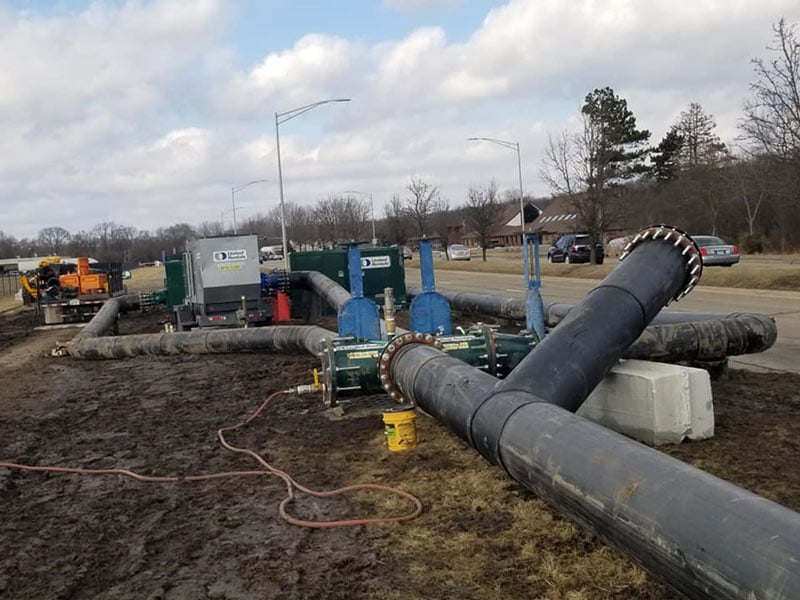
A pigging port facilitated easy cleaning for the bypass lines.
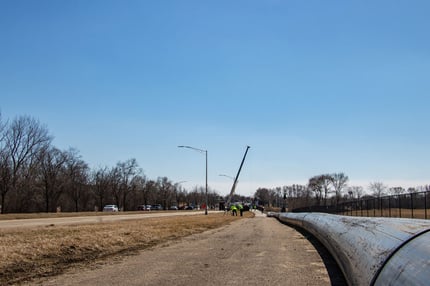
The work was broken out into two sections, the upper and lower bypass—the upper bypass encompassing eight setups coming in at 1,000 feet each, and the lower bypass equaling 2,600 linear feet.
The upper bypass was longer with a higher developed head but with less design flow, while the lower bypass was shorter but needed to accommodate greater flows. So both bypasses fit on the same pump systems’ head curve, and both the upper and lower bypass setups were able to use the same pipes and pumps.
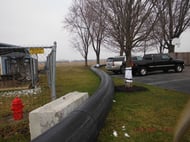 The upper bypass had to work around the fire station, airport, and numerous small creeks. None of the bypass segments could encroach on the airport property, so large concrete blocks were used to contour the bypass pipe around the perimeter of the airport grounds.
The upper bypass had to work around the fire station, airport, and numerous small creeks. None of the bypass segments could encroach on the airport property, so large concrete blocks were used to contour the bypass pipe around the perimeter of the airport grounds.
The bypass lines crossed numerous small creeks and the I&M canal. While the smaller crossings used metal or wood scaffolding to support the pipe as it crossed, longer crossings required a different approach—large pipe floats. It was determined that the canal where the crossing took place was not navigable, so a large, elevated structure was not required. With that determination, the USACE approved a single float to cross the I&M canal.
They only stipulated that work be completed by January—so as not to impede the winter snowmobile users who enjoy the canal trail—and that no pipe joints be present in the section of pipeline that spanned the canal. A series of floats were needed to cross a creek under a roadway.
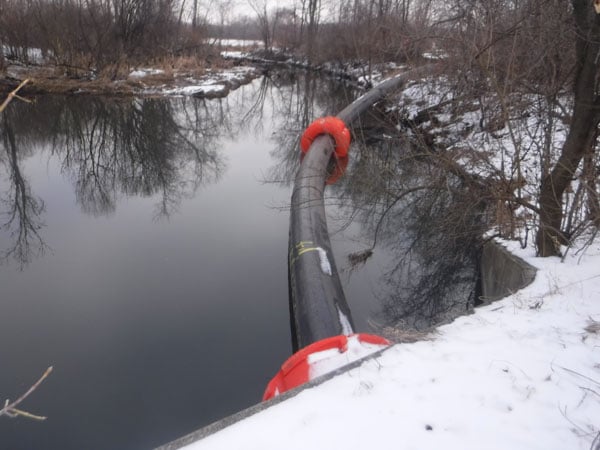
Floats eliminated the need for larger structures to support the bypass lines for larger creek crossings.
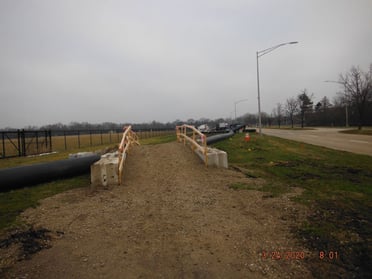
The bypass lines also crossed a nature trail as it traversed the forest preserve. The problem was the Forest Preserve District of Will County, and the Joliet Park District stipulated that the trail must remain open throughout the project. For most areas, this wasn’t an issue, as the pipeline could be routed to allow trail access. However, one intersection required a bridge to be constructed to enable trail users to cross over the large bypass lines uninhibited safely.
An earthworks bridge was also constructed to maintain access to the trail near the fire station.
Massive machinery was brought in to facilitate construction for all the CIPP lining and bypass setups. This meant multi-ton vehicles were driving through delicate forest preserve landscapes, the largest being a tractor-trailer weighing a whopping 90,000 pounds.
The truck was so heavy that the team had to acquire special permits to even drive on the roadways to get to the construction site.
RJN worked with forest preserve staff to identify and remove the minimum amount of trees necessary for work to proceed. For the remaining trees in the immediate project area, trunk padding was applied to protect them from damage.
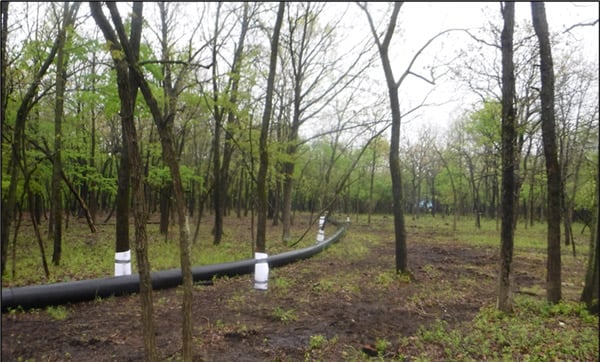
Trunk padding was used to protect trees immediately adjacent to the bypass lines.
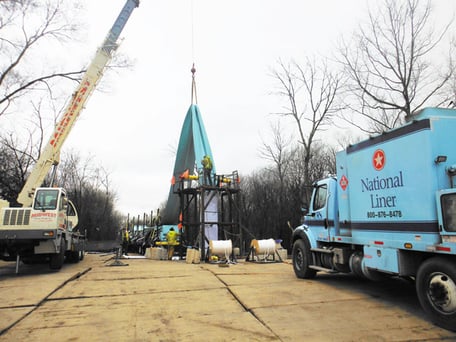 Once this took place, the contractor began building a new floor for the forest. This floor comprised swamp mats, which covered every area of the forest preserve ground where the equipment would be driven. This fact made it especially tricky to navigate that 45-ton truck on a minuscule footprint.
Once this took place, the contractor began building a new floor for the forest. This floor comprised swamp mats, which covered every area of the forest preserve ground where the equipment would be driven. This fact made it especially tricky to navigate that 45-ton truck on a minuscule footprint.
Further complicating matters, two 30-inch high-pressure gas transmission pipelines also crossed the area. The gas company required that anywhere equipment or bypass piping crossed their pipelines be protected. This significantly expanded the number of swamp mats needed.
Construction was ready to begin after putting down countless swamp mats; however, heavy rain threw a wrench into the mix. The thing about swamp mats is that while they are incredibly stout, they are also quite buoyant. So when torrential rainfall hit the area, all of the mats began to float away. Fortunately, they didn’t go very far.
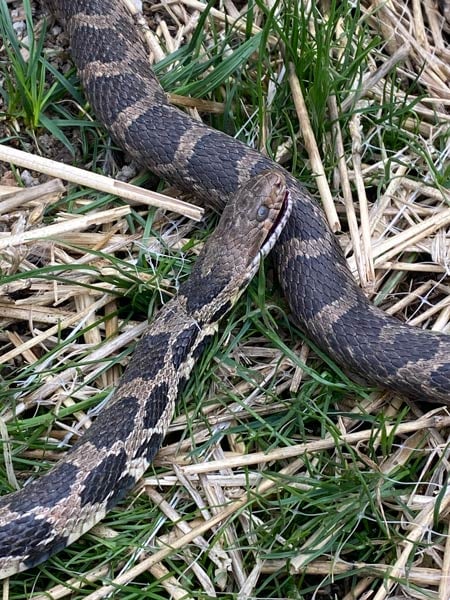
Environmental protections were also installed for the local wildlife. For example, the typical erosion control blankets used to prevent washout in construction sites posed a problem for area fox snakes, as they would become entangled in the netting. Special blankets were used instead so that the snakes could come and go as they pleased.
Additional protections were achieved because the forest preserve required that all equipment be thoroughly washed and cleaned before entering the preserve property. This reduced potential contamination and also made for squeaky-clean construction vehicles.
With all the preparations in place, the contractor began the lining process. While it took two weeks to set up the lower bypass setups, it only took four days to complete the lining. The lining went as planned; however, a few snags were encountered along the way.
When it came to the segments near the airport, cranes were not permitted due to the runway approach, so the plan had to be adjusted.
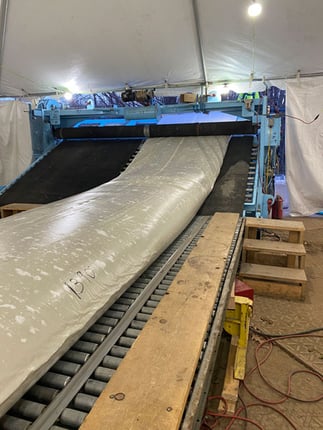 The upper section of the project was designed to be completed during the winter months so that trail usage would be at a minimum; however, this posed a few challenges for curing pipes underground. A sacrificial temperature sensing wire was run throughout the alignment to ensure the proper temperature was achieved to reach a complete cure. Additionally, heated tents were constructed to allow for the wet-out process to be completed despite frigid temperatures.
The upper section of the project was designed to be completed during the winter months so that trail usage would be at a minimum; however, this posed a few challenges for curing pipes underground. A sacrificial temperature sensing wire was run throughout the alignment to ensure the proper temperature was achieved to reach a complete cure. Additionally, heated tents were constructed to allow for the wet-out process to be completed despite frigid temperatures.
Obtaining enough water to fill large diameter pipelines in the middle of a forest preserve also added a degree of difficulty to the project. Water had to be pumped to the project site from approximately 2,000 feet away, which required a booster pump to help get the flow to its destination.
With the water on-site, the CIPP was filled and brought to a boil. Despite all the challenges and the frigid ground, a perfect cure was achieved. After the lining was completed, post-inspection CCTV footage showed that no sections required spot lining or repair.
Manholes along the alignment were concurrently rehabilitated via epoxy liner. So the challenge was to reconcile the difference in material thickness between the CIPP and the epoxy coating. To do this, RJN engineers worked with the epoxy manufacturer to formulate a thicker epoxy coating that would seamlessly blend the manhole with the thickness of the new CIPP to create a rigid, water-tight structure.
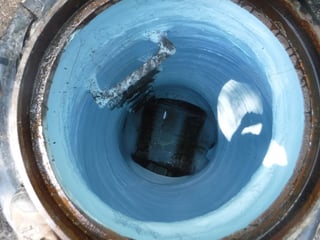
The winter weather also created challenges for manhole rehabilitation efforts. For the epoxy to cure, temperatures had to be above freezing. This was achieved by placing tents over the manholes and heating the tents while work was performed. This raised the ambient temperatures of the structure and enabled proper curing to occur. The workers also welcomed heated tents.
Several manholes were in flood zones, with some towering 10 feet above the ground. Linings were applied to these taller structures above the flood line to ensure sewer flows stayed within the pipelines in the event of surcharge conditions.
With the vast array of work performed throughout this project, ensuring safety was maintained at all times was imperative. Extensive confined space entry was required for lining and the manhole rehabilitation. With work being performed near waterways, barriers to catch floaters were utilized, and spill plans were developed in case of an overflow event. Before being put into service, the bypass lines were filled with clean water to check for leaks.
Redundancy was designed into the bypass setup to ensure service viability. A technician with parts was on-site 24/7 to monitor the pumps and immediately affect repairs in the event of an issue with one of the pumps.
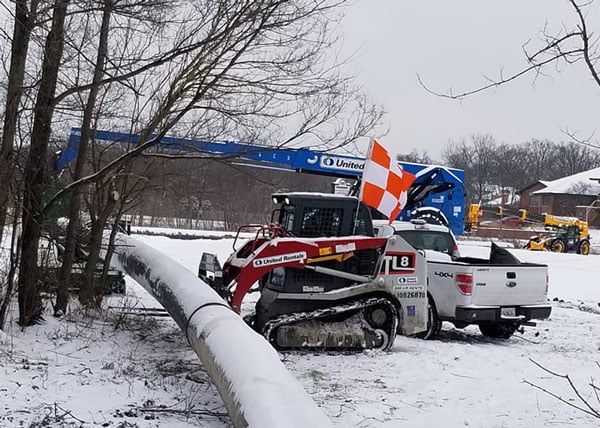 As we have already learned, working around the airport can be contentious at times. While making the appropriate accommodations for bypass and lining construction, crews placed high-visibility flags on all construction equipment. While this is understandable in most cases, it did provide a little comic relief for “the little skid-steer that could,” as even a tiny vehicle gets a flag.
As we have already learned, working around the airport can be contentious at times. While making the appropriate accommodations for bypass and lining construction, crews placed high-visibility flags on all construction equipment. While this is understandable in most cases, it did provide a little comic relief for “the little skid-steer that could,” as even a tiny vehicle gets a flag.
All of the standard public outreach efforts were made for this project, including:
Work began early to generate buy-in from stakeholders. Condition images were shared with relevant parties to impress upon them the necessity of repairing the RRI before a failure occurred.
While used far less during the winter months, the trail was kept open and accessible throughout the project, save for temporary closures to allow work to be done. Press releases were distributed to inform the public about trail detours and temporary closures, and temporary structures were built to ensure the public could safely cross over the large bypass pipelines.
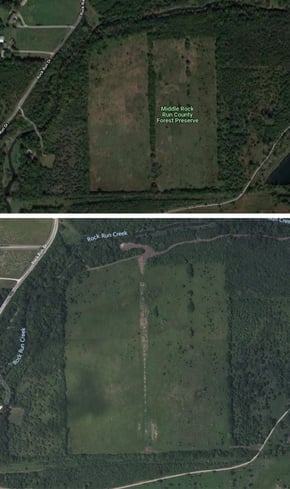 Besides the fact that the RRI’s structural integrity was restored and that it would effectively and efficiently carry vast qualities of sewer flows for the foreseeable future, the project had a few other lasting impacts for the area.
Besides the fact that the RRI’s structural integrity was restored and that it would effectively and efficiently carry vast qualities of sewer flows for the foreseeable future, the project had a few other lasting impacts for the area.
While the tree-cutting crews were on site, an additional swath of trees was removed from between two prairies as part of forest preserve negotiations. This helped the forest preserve achieve its goal of creating a single unified prairie. None of the trees that were removed were chipped on site. This ensured the aesthetics of the areas were preserved and also maintained a clean, natural appearance for forest preserve visitors.
Even though swamp mats were used, the nature trail bore the tale-tale signs of heavy construction equipment. So remediation efforts were made to restore the trail, which ultimately saw its condition improved to a greater degree than before the project was started.
The only significant delay the project encountered was due to wet-weather. With heavy rainfall, bypass pumping becomes increasingly risky as surcharge conditions can quickly overload the system’s capacity.
The project went off without a hitch and was a resounding success, thanks in part to the incredible level of planning and coordination. While negotiations with the forest preserve caused a bit of scope creep—cutting down an entire swath of trees that divide two huge prairies will do that—overall, the project was completed on budget and within the adjusted time frame.
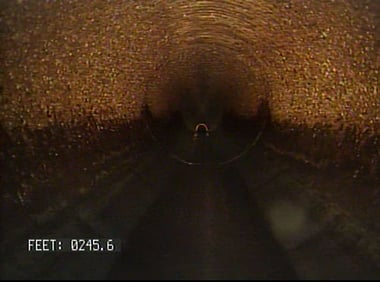
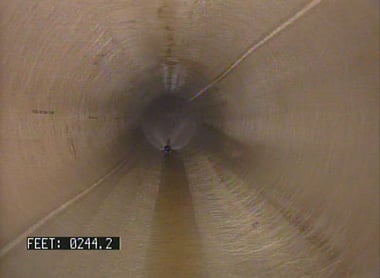
Rock Run Interceptor pre- and post-rehabilitation.
Despite all of the challenges, 13,689 linear feet of 30- to 48-inch interceptor was lined, and 111 manholes were rehabilitated.

RJN Group, Inc., is an award-winning engineering firm specializing in the asse...